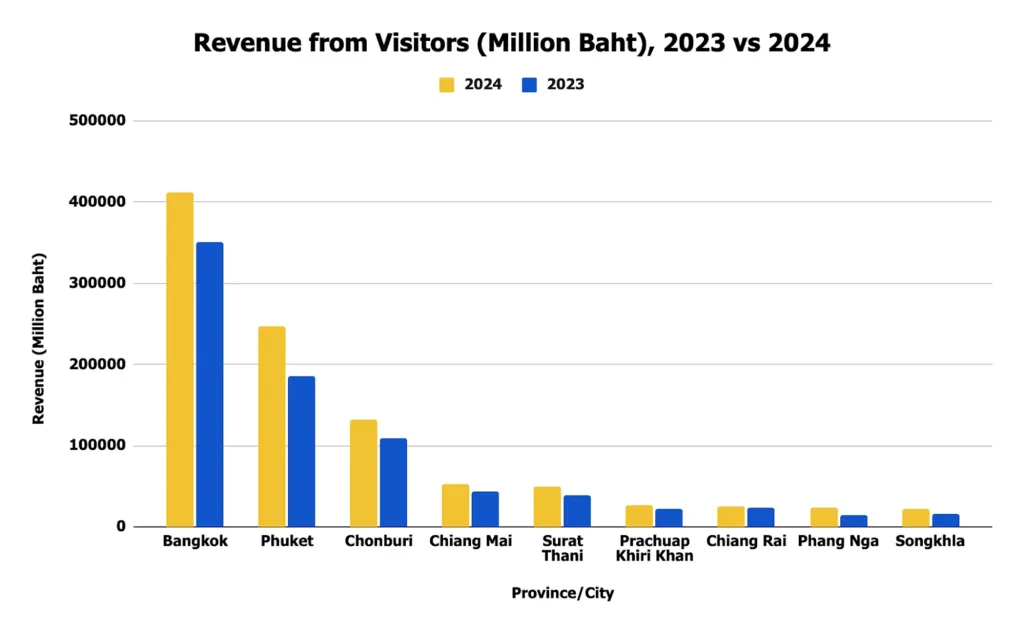Eco tourism Thailand is a rising pillar of the country’s travel economy. In 2024, eco-tourism accounts for 10% of Thailand’s tourism revenue, valued at USD 33.2 million. With a projected 15.8% annual growth rate, the market is on track to reach USD 143.9 million by 2034.
The shift isn’t only policy-driven, but people-powered. 65% of Thai travelers say they’re willing to pay more for sustainable travel experiences. This shows a strong local appetite for ethical, green tourism, adding momentum to the country’s national recovery strategy.
Post-Pandemic Travel Shifts Spark Local and Safe Choices
Since the pandemic, Thai travel behavior has changed. 51% of Thai tourists now prefer domestic trips, favoring familiar, safe locations. Shorter getaways and destinations with fewer crowds are now the norm. When restrictions were first lifted, 20% of Thais were ready to travel right away, showing strong local demand compared to neighboring countries.
Top concerns remain safety and ease. 67% of travelers cited vaccination status as their top priority when resuming trips. This has led to a growing preference for digital and contactless services, from booking to payment.
Read Also: Smart Moves Behind Thai Strategies for Tourism Recovery
Eco Tourism Thailand: Roadmap
Thailand’s recovery plan includes bold green initiatives. The Thailand Green Tourism Collections highlights 20 curated eco-routes across 10 green cities, including Chiang Mai, Bangkok, Nan, and Krabi. These routes focus on low-impact travel, community-based tourism, and environmental preservation.

But there’s still work to do. Only 1% of hotels in Thailand currently meet international sustainability standards. This gap presents both a challenge and an opportunity for hotel operators to modernize and meet global expectations.
To stay competitive, Thailand is also working with EU tour operators to align with evolving international sustainability rules, ensuring it attracts eco-conscious global travelers.
Where Wellness and Eco Meet: Top Eco Tourism Thailand Destinations
Thailand’s leading wellness and eco-tourism destinations—Chiang Mai, Pai, Phuket, Koh Phangan, and Koh Samui—offer everything from forest retreats to beachfront yoga. In places like Koh Samui, sustainability blends with serenity, anchoring Thailand’s USD 33.2 million eco-tourism economy.
Resorts like Zeavola on Phi Phi Island serve as models for eco-friendly hospitality. Their waste reduction practices and support for local communities have earned international recognition.
Medical Tourism: A High-Value Piece of the Puzzle
Though fewer than 9% of visitors come for medical reasons, they have a powerful impact. Medical tourists spend an average of $4,200 over two weeks or more than triple the $1,300 spent by typical leisure travelers in just six days. Medical tourism now makes up 0.4% of Thailand’s GDP, cementing its role as a strategic sector for attracting high-value guests.
Read Also: Thailand Medical Tourism 2.0: Integrated Care Hubs in Phuket & Bangkok
Tourism Incentives and Private Sector Partnerships
The Thai government is betting big on tourism’s rebound. It has expanded visa-free entry, extended stay durations, and allocated 600 million baht (USD 16 million) for peak season promotions. A new 50% local travel subsidy is also expected to boost economic impact by 5–10% over earlier schemes.
Public-private programs like Green Tourism Collections and co-payment travel campaigns show how collaboration is driving sustainable growth.
Eco Tourism Thailand: A Greener, Smarter Tourism Model
With an expected 40 million tourists in 2025, Thailand is well on its way to recovery and reinvention. If trends continue, the country could hit 50 million annual visitors by 2030, driven by eco-savvy and wellness-focused travelers.
Eco tourism Thailand is at the heart of this shift. Backed by local demand, government action, and industry innovation, sustainable travel is no longer optional—it’s Thailand’s path forward.







